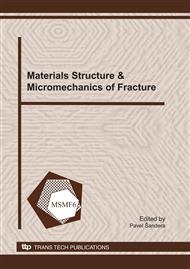p.511
p.515
p.519
p.523
p.527
p.531
p.535
p.539
p.543
Damage Progression and Residual Strength Evaluation in Sandwich Panels Loaded at the Center
Abstract:
This paper addresses damage evaluation of loaded sandwich panels by using acoustic emission (AE) as a non-destructive method. The specimens were loaded monotonically out-of-plane in control of displacement and the tests were stopped at three different damage levels. Each loading level activates different failure mechanism that can influence on residual strength of material. After each quasi-static test, the damaged plate was cut by a diamond saw to obtain tensile specimens. After cutting, compression test carried out by using acoustic emission to monitor the process. Depend on loading level the damage value was variant as it caused different residual strength that was related to acoustic emission signals activities. There is a relation between AE signal energy and mechanical energy that can follow to evaluate the residual strength of panels in different loading level in sandwich panels. Results show that the using AE method having mechanical results can be effective in residual strength and progressive damage evolution.
Info:
Periodical:
Pages:
527-530
Citation:
Online since:
January 2011
Keywords:
Price:
Сopyright:
© 2011 Trans Tech Publications Ltd. All Rights Reserved
Share:
Citation:


